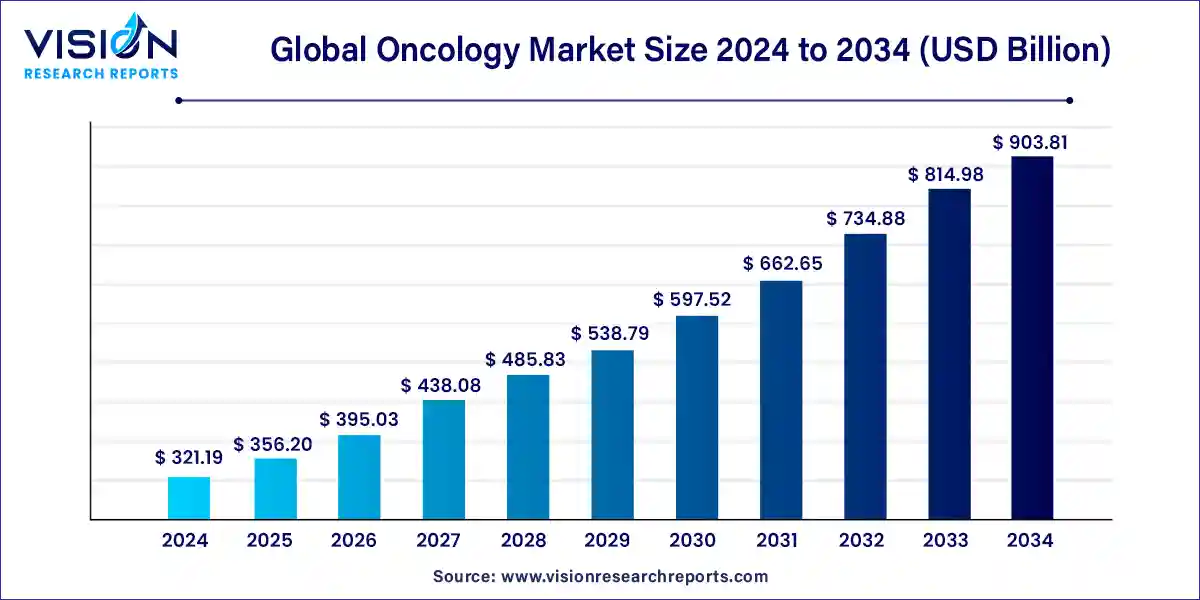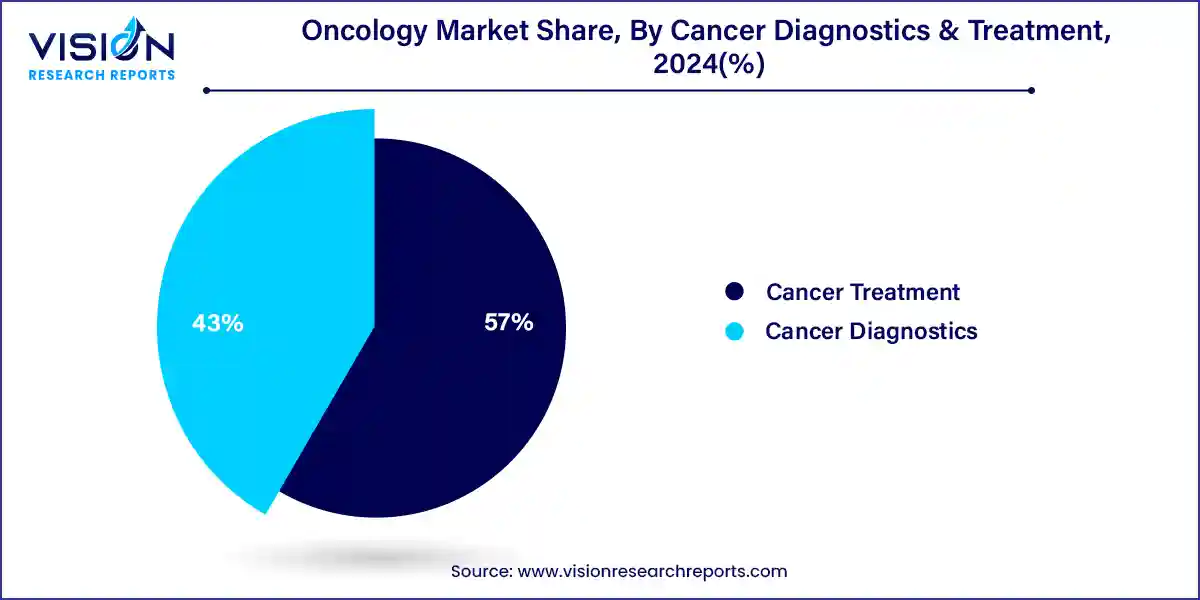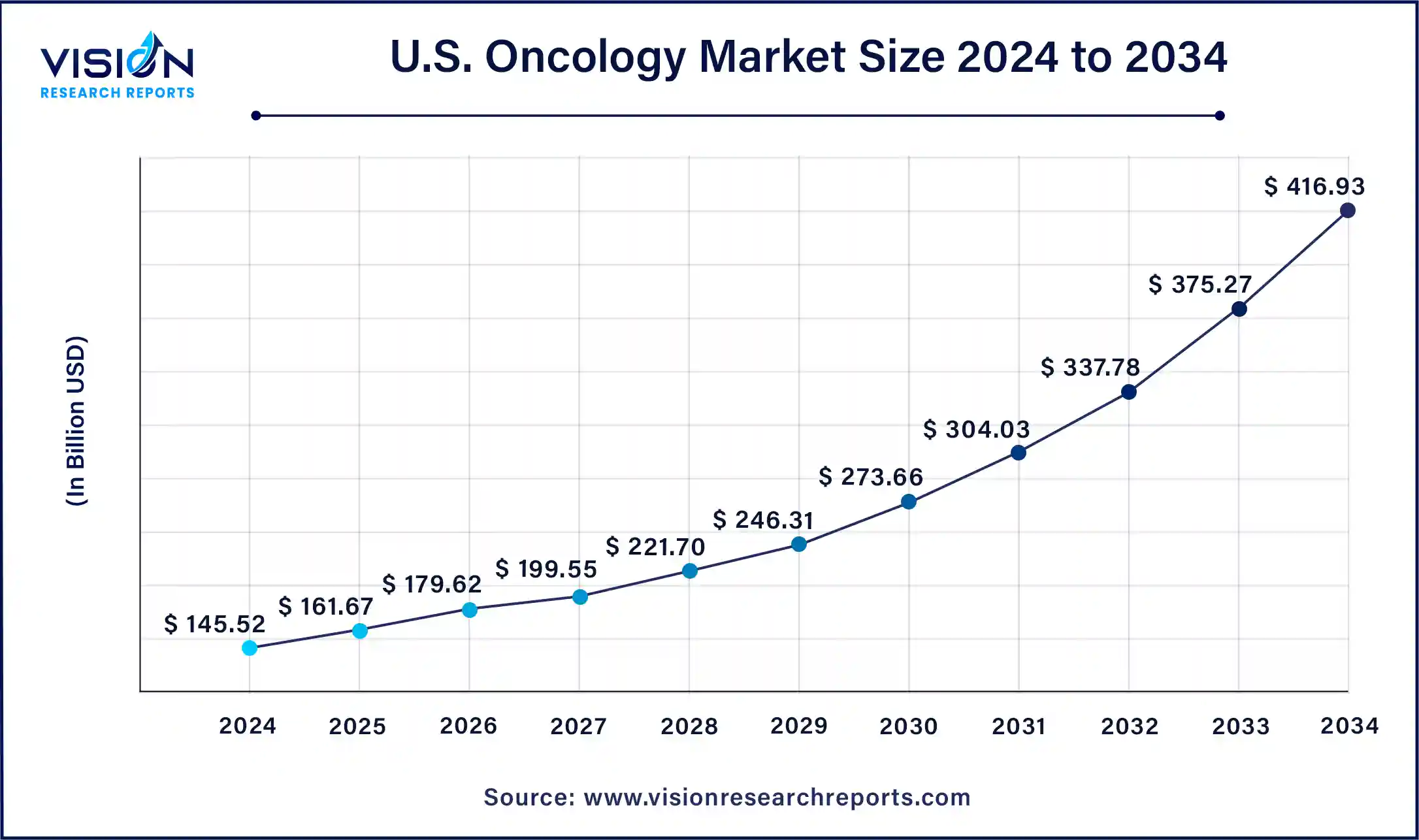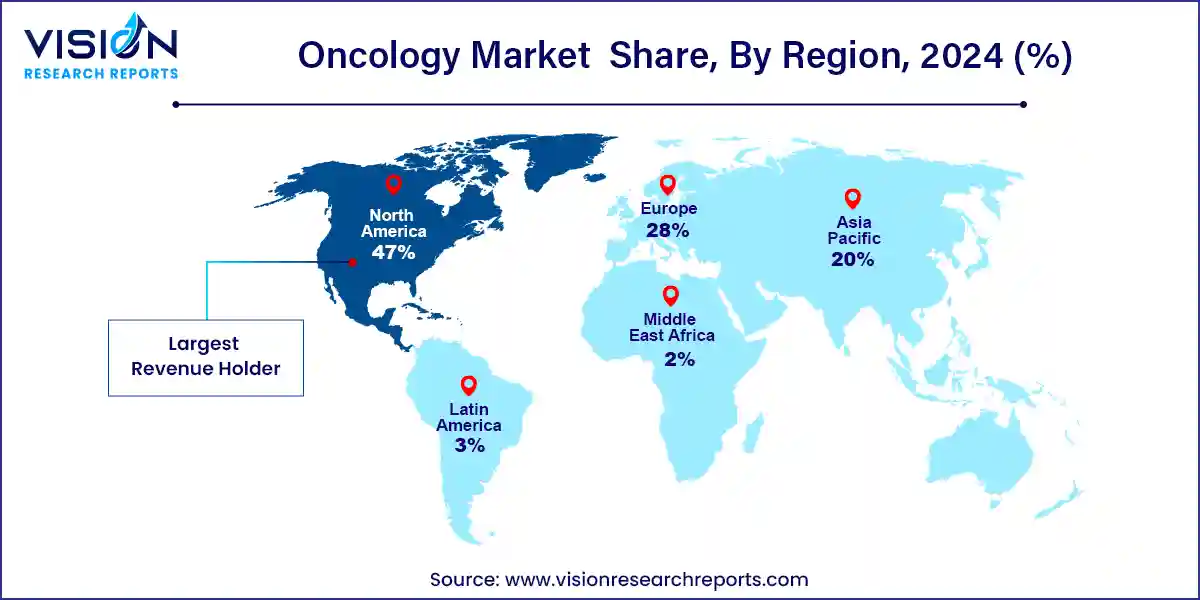The global oncology market size was valued at USD 321.19 billion in 2024 and is projected to surpass around USD 903.81 billion by 2034, registering a CAGR of 10.9% over the forecast period of 2025 to 2034.

The field of oncology has witnessed dynamic shifts in recent years, propelled by advancements in research, technology, and treatment modalities. This overview delves into the current landscape of the oncology market, highlighting key trends, addressing challenges, and exploring emerging opportunities that shape the industry.
The growth of the oncology market is propelled by multifaceted factors contributing to its expansion. Primarily, advancements in research and technology have ushered in a new era of targeted therapies, such as immunotherapy and precision medicine, which have significantly improved treatment outcomes. The increasing prevalence of cancer worldwide and the rising aging population further amplify the demand for innovative oncology solutions. Additionally, robust investment in oncology research and development by pharmaceutical companies, coupled with supportive regulatory frameworks, has expedited the introduction of novel drugs and therapies. The collaborative efforts between industry stakeholders, research institutions, and healthcare providers also play a pivotal role in accelerating market growth, fostering the exchange of knowledge and resources. As a result, the dynamic interplay of scientific progress, demographic trends, investment, and collaboration collectively contributes to the sustained expansion of the oncology market.
| Report Attribute | Details |
| Market Size in 2025 | USD 356.2 Billion |
| Market Size by 2033 | USD 903.81 Billion |
| Growth Rate From 2024 to 2033 | CAGR of 10.9% |
| Base Year | 2024 |
| Forecast Period | 2025 to 2034 |
| Segments Covered | Cancer Diagnostics & Treatment, Indication, Region |
| Market Analysis (Terms Used) | Value (US$ Million/Billion) or (Volume/Units) |
| Report Coverage | Revenue forecast, company ranking, competitive landscape, growth factors, and trends |
| Key Companies Profiled | Aegerion Pharmaceuticals Inc., Abbvie Inc., Ability Pharma, Acadia Pharmaceuticals Inc., Amgen Inc., Takeda Oncology, Aslan Pharmaceuticals Ltd., Aspen Pharmacare Holdings Limited., Astrazeneca, Athenex, Inc. |
In 2024, the cancer treatment sector held the largest revenue share of 57%. This is attributed to the growing adoption of both traditional chemotherapy and immunotherapy for global cancer treatment. There is a shifting trend towards targeted therapy and immunotherapy due to their increased convenience, effectiveness, and lower side effects compared to traditional chemotherapy. The targeted therapy's low toxicity and its ability to specifically target cancer cells, sparing normal cells, are key factors propelling substantial growth in the cancer treatment segment. Additionally, heightened awareness among the global population about the advantages of targeted therapy, hormonal therapy, and immunotherapy is driving increased demand for these advanced cancer treatments.

Conversely, the cancer diagnostics segment is poised as the most opportunistic sector. The rising awareness of cancer-related issues globally is driving increased demand for cancer diagnostics. The growing preference for early cancer detection among individuals is a significant factor propelling the expansion of the cancer diagnostics segment. The availability of diverse non-invasive and user-friendly diagnostic tools is expected to contribute significantly to the growth of this segment throughout the forecast period.
In 2024, the lung cancer segment emerged as the dominant force in the market, primarily driven by the escalating global incidence of lung cancer. Notably, the International Agency for Research on Cancer reported approximately 1.8 million deaths attributed to lung cancer in 2020. It stands as the most prevalent cancer type worldwide, contributing to 18% of global cancer-related fatalities. Recognized as the leading cause of cancer deaths, the surge in global smoking prevalence stands out as a significant factor propelling the growth of the lung cancer segment.
Conversely, breast cancer is poised to be the fastest-growing market segment during the forecast period. This projection is attributed to the rising prevalence of breast cancer among the female population. According to the International Agency for Research on Cancer, breast cancer surpassed lung cancer as the most diagnosed cancer type in 2020, with approximately 2.3 million cases reported, accounting for 11.72% of all new cancer cases. This shift underscores the increasing significance of breast cancer in the global landscape, marking it as a key area for market growth in the coming years.
U.S. Oncology Market Size and Growth 2025 to 2034
The U.S. oncology market size was exhibited at USD 145.52 billion in 2024 and is projected to be worth around USD 416.93 billion by 2034, growing at a CAGR of 11.1% from 2025 to 2034.

In 2024, North America asserted its dominance in the global oncology market, primarily driven by the heightened prevalence of cancer in major markets such as the United States. According to the American Cancer Society, the US reported over 1.8 million new cancer cases and 606,520 deaths in 2020. The prevalent types of cancer in North America include lung cancer, colorectal cancer, breast cancer, and prostate cancer. The North American oncology market is expected to maintain its leading position, supported by well-developed healthcare infrastructure and increased healthcare expenditure. The substantial adoption of oncology treatments in the US has contributed to a remarkable 29% decline in cancer-related deaths since 1991.

Conversely, Europe is poised to emerge as the most opportunistic market during the forecast period. This is attributed to the increasing technological advancements in cancer diagnostics. Additionally, the rising incidence of cancer and a growing number of cancer-related deaths across Europe are anticipated to drive the growth of the European oncology market in the coming years. According to the European Commission, approximately 2.7 million new cancer cases and about 1.3 million cancer deaths were recorded in 2020, underscoring the significance of the region in the global oncology landscape.
By Cancer Diagnostics & Treatment
By Indication
By End-use
By Region
Chapter 1. Introduction
1.1. Research Objective
1.2. Scope of the Study
1.3. Definition
Chapter 2. Research Methodology
2.1. Research Approach
2.2. Data Sources
2.3. Assumptions & Limitations
Chapter 3. Executive Summary
3.1. Market Snapshot
Chapter 4. Market Variables and Scope
4.1. Introduction
4.2. Market Classification and Scope
4.3. Industry Value Chain Analysis
4.3.1. Raw Material Procurement Analysis
4.3.2. Sales and Distribution Cancer Diagnostics & Treatment Analysis
4.3.3. Downstream Buyer Analysis
Chapter 5. COVID 19 Impact on Oncology Market
5.1. COVID-19 Landscape: Oncology Industry Impact
5.2. COVID 19 - Impact Assessment for the Industry
5.3. COVID 19 Impact: Global Major Government Policy
5.4. Market Trends and Opportunities in the COVID-19 Landscape
Chapter 6. Market Dynamics Analysis and Trends
6.1. Market Dynamics
6.1.1. Market Drivers
6.1.2. Market Restraints
6.1.3. Market Opportunities
6.2. Porter’s Five Forces Analysis
6.2.1. Bargaining power of suppliers
6.2.2. Bargaining power of buyers
6.2.3. Threat of substitute
6.2.4. Threat of new entrants
6.2.5. Degree of competition
Chapter 7. Competitive Landscape
7.1.1. Company Market Share/Positioning Analysis
7.1.2. Key Strategies Adopted by Players
7.1.3. Vendor Landscape
7.1.3.1. List of Suppliers
7.1.3.2. List of Buyers
Chapter 8. Global Oncology Market, By Cancer Diagnostics & Treatment
8.1. Oncology Market, by Cancer Diagnostics & Treatment, 2024-2033
8.1.1 Cancer Diagnostics
8.1.1.1. Market Revenue and Forecast (2021-2033)
8.1.2. Cancer Treatment
8.1.2.1. Market Revenue and Forecast (2021-2033)
Chapter 9. Global Oncology Market, By Indication
9.1. Oncology Market, by Indication, 2024-2033
9.1.1. Lungs Cancer
9.1.1.1. Market Revenue and Forecast (2021-2033)
9.1.2. Colorectal Cancer
9.1.2.1. Market Revenue and Forecast (2021-2033)
9.1.3. Breast Cancer
9.1.3.1. Market Revenue and Forecast (2021-2033)
9.1.4. Liver Cancer
9.1.4.1. Market Revenue and Forecast (2021-2033)
9.1.5. Bladder Cancer
9.1.5.1. Market Revenue and Forecast (2021-2033)
9.1.6. Head & Neck Cancer
9.1.6.1. Market Revenue and Forecast (2021-2033)
9.1.7. Prostate Cancer
9.1.7.1. Market Revenue and Forecast (2021-2033)
9.1.8. Others
9.1.8.1. Market Revenue and Forecast (2021-2033)
Chapter 10. Global Oncology Market, By End-use
10.1. Oncology Market, by End-use, 2024-2033
10.1.1. Hospitals
10.1.1.1. Market Revenue and Forecast (2021-2033)
10.1.2. Diagnostic laboratories
10.1.2.1. Market Revenue and Forecast (2021-2033)
10.1.3. Diagnostic imaging centers
10.1.3.1. Market Revenue and Forecast (2021-2033)
10.1.4. Academia
10.1.4.1. Market Revenue and Forecast (2021-2033)
10.1.5. Specialty clinics
10.1.5.1. Market Revenue and Forecast (2021-2033)
10.1.6. Others
10.1.6.1. Market Revenue and Forecast (2021-2033)
Chapter 11. Global Oncology Market, Regional Estimates and Trend Forecast
11.1. North America
11.1.1. Market Revenue and Forecast, by Cancer Diagnostics & Treatment (2021-2033)
11.1.2. Market Revenue and Forecast, by Indication (2021-2033)
11.1.3. Market Revenue and Forecast, by End-use (2021-2033)
11.1.4. U.S.
11.1.4.1. Market Revenue and Forecast, by Cancer Diagnostics & Treatment (2021-2033)
11.1.4.2. Market Revenue and Forecast, by Indication (2021-2033)
11.1.4.3. Market Revenue and Forecast, by End-use (2021-2033)
11.1.5. Rest of North America
11.1.5.1. Market Revenue and Forecast, by Cancer Diagnostics & Treatment (2021-2033)
11.1.5.2. Market Revenue and Forecast, by Indication (2021-2033)
11.1.5.3. Market Revenue and Forecast, by End-use (2021-2033)
11.2. Europe
11.2.1. Market Revenue and Forecast, by Cancer Diagnostics & Treatment (2021-2033)
11.2.2. Market Revenue and Forecast, by Indication (2021-2033)
11.2.3. Market Revenue and Forecast, by End-use (2021-2033)
11.2.4. UK
11.2.4.1. Market Revenue and Forecast, by Cancer Diagnostics & Treatment (2021-2033)
11.2.4.2. Market Revenue and Forecast, by Indication (2021-2033)
11.2.4.3. Market Revenue and Forecast, by End-use (2021-2033)
11.2.5. Germany
11.2.5.1. Market Revenue and Forecast, by Cancer Diagnostics & Treatment (2021-2033)
11.2.5.2. Market Revenue and Forecast, by Indication (2021-2033)
11.2.5.3. Market Revenue and Forecast, by End-use (2021-2033)
11.2.6. France
11.2.6.1. Market Revenue and Forecast, by Cancer Diagnostics & Treatment (2021-2033)
11.2.6.2. Market Revenue and Forecast, by Indication (2021-2033)
11.2.6.3. Market Revenue and Forecast, by End-use (2021-2033)
11.2.7. Rest of Europe
11.2.7.1. Market Revenue and Forecast, by Cancer Diagnostics & Treatment (2021-2033)
11.2.7.2. Market Revenue and Forecast, by Indication (2021-2033)
11.2.7.3. Market Revenue and Forecast, by End-use (2021-2033)
11.3. APAC
11.3.1. Market Revenue and Forecast, by Cancer Diagnostics & Treatment (2021-2033)
11.3.2. Market Revenue and Forecast, by Indication (2021-2033)
11.3.3. Market Revenue and Forecast, by End-use (2021-2033)
11.3.4. India
11.3.4.1. Market Revenue and Forecast, by Cancer Diagnostics & Treatment (2021-2033)
11.3.4.2. Market Revenue and Forecast, by Indication (2021-2033)
11.3.4.3. Market Revenue and Forecast, by End-use (2021-2033)
11.3.5. China
11.3.5.1. Market Revenue and Forecast, by Cancer Diagnostics & Treatment (2021-2033)
11.3.5.2. Market Revenue and Forecast, by Indication (2021-2033)
11.3.5.3. Market Revenue and Forecast, by End-use (2021-2033)
11.3.6. Japan
11.3.6.1. Market Revenue and Forecast, by Cancer Diagnostics & Treatment (2021-2033)
11.3.6.2. Market Revenue and Forecast, by Indication (2021-2033)
11.3.6.3. Market Revenue and Forecast, by End-use (2021-2033)
11.3.7. Rest of APAC
11.3.7.1. Market Revenue and Forecast, by Cancer Diagnostics & Treatment (2021-2033)
11.3.7.2. Market Revenue and Forecast, by Indication (2021-2033)
11.3.7.3. Market Revenue and Forecast, by End-use (2021-2033)
11.4. MEA
11.4.1. Market Revenue and Forecast, by Cancer Diagnostics & Treatment (2021-2033)
11.4.2. Market Revenue and Forecast, by Indication (2021-2033)
11.4.3. Market Revenue and Forecast, by End-use (2021-2033)
11.4.4. GCC
11.4.4.1. Market Revenue and Forecast, by Cancer Diagnostics & Treatment (2021-2033)
11.4.4.2. Market Revenue and Forecast, by Indication (2021-2033)
11.4.4.3. Market Revenue and Forecast, by End-use (2021-2033)
11.4.5. North Africa
11.4.5.1. Market Revenue and Forecast, by Cancer Diagnostics & Treatment (2021-2033)
11.4.5.2. Market Revenue and Forecast, by Indication (2021-2033)
11.4.5.3. Market Revenue and Forecast, by End-use (2021-2033)
11.4.6. South Africa
11.4.6.1. Market Revenue and Forecast, by Cancer Diagnostics & Treatment (2021-2033)
11.4.6.2. Market Revenue and Forecast, by Indication (2021-2033)
11.4.6.3. Market Revenue and Forecast, by End-use (2021-2033)
11.4.7. Rest of MEA
11.4.7.1. Market Revenue and Forecast, by Cancer Diagnostics & Treatment (2021-2033)
11.4.7.2. Market Revenue and Forecast, by Indication (2021-2033)
11.4.7.3. Market Revenue and Forecast, by End-use (2021-2033)
11.5. Latin America
11.5.1. Market Revenue and Forecast, by Cancer Diagnostics & Treatment (2021-2033)
11.5.2. Market Revenue and Forecast, by Indication (2021-2033)
11.5.3. Market Revenue and Forecast, by End-use (2021-2033)
11.5.4. Brazil
11.5.4.1. Market Revenue and Forecast, by Cancer Diagnostics & Treatment (2021-2033)
11.5.4.2. Market Revenue and Forecast, by Indication (2021-2033)
11.5.4.3. Market Revenue and Forecast, by End-use (2021-2033)
11.5.5. Rest of LATAM
11.5.5.1. Market Revenue and Forecast, by Cancer Diagnostics & Treatment (2021-2033)
11.5.5.2. Market Revenue and Forecast, by Indication (2021-2033)
11.5.5.3. Market Revenue and Forecast, by End-use (2021-2033)
Chapter 12. Company Profiles
12.1. Aegerion Pharmaceuticals Inc.
12.1.1. Company Overview
12.1.2. Product Offerings
12.1.3. Financial Performance
12.1.4. Recent Initiatives
12.2. Abbvie Inc.
12.2.1. Company Overview
12.2.2. Product Offerings
12.2.3. Financial Performance
12.2.4. Recent Initiatives
12.3. Ability Pharma.
12.3.1. Company Overview
12.3.2. Product Offerings
12.3.3. Financial Performance
12.3.4. Recent Initiatives
12.4. Acadia Pharmaceuticals Inc.
12.4.1. Company Overview
12.4.2. Product Offerings
12.4.3. Financial Performance
12.4.4. Recent Initiatives
12.5. Amgen Inc.
12.5.1. Company Overview
12.5.2. Product Offerings
12.5.3. Financial Performance
12.5.4. Recent Initiatives
12.6. Takeda Oncology
12.6.1. Company Overview
12.6.2. Product Offerings
12.6.3. Financial Performance
12.6.4. Recent Initiatives
12.7. Aslan Pharmaceuticals Ltd.
12.7.1. Company Overview
12.7.2. Product Offerings
12.7.3. Financial Performance
12.7.4. Recent Initiatives
12.8. Aspen Pharmacare Holdings Limited.
12.8.1. Company Overview
12.8.2. Product Offerings
12.8.3. Financial Performance
12.8.4. Recent Initiatives
12.9. Astrazeneca.
12.9.1. Company Overview
12.9.2. Product Offerings
12.9.3. Financial Performance
12.9.4. Recent Initiatives
12.10. Athenex, Inc.
12.10.1. Company Overview
12.10.2. Product Offerings
12.10.3. Financial Performance
12.10.4. Recent Initiatives
Chapter 13. Research Methodology
13.1. Primary Research
13.2. Secondary Research
13.3. Assumptions
Chapter 14. Appendix
14.1. About Us
14.2. Glossary of Terms
 Cross-segment Market Size and Analysis for
Mentioned Segments
Cross-segment Market Size and Analysis for
Mentioned Segments
 Additional Company Profiles (Upto 5 With No Cost)
Additional Company Profiles (Upto 5 With No Cost)
 Additional Countries (Apart From Mentioned Countries)
Additional Countries (Apart From Mentioned Countries)
 Country/Region-specific Report
Country/Region-specific Report
 Go To Market Strategy
Go To Market Strategy
 Region Specific Market Dynamics
Region Specific Market Dynamics Region Level Market Share
Region Level Market Share Import Export Analysis
Import Export Analysis Production Analysis
Production Analysis Others
Others